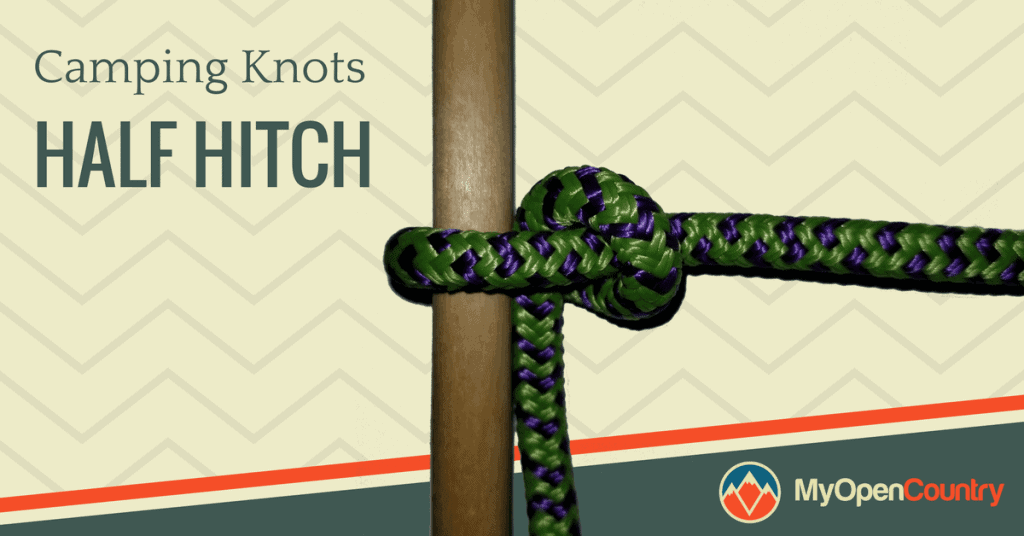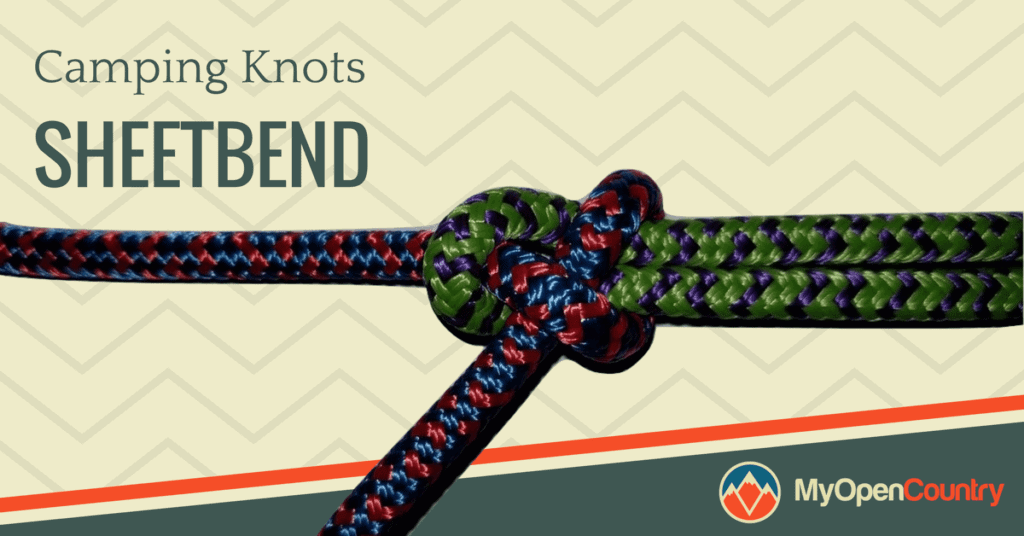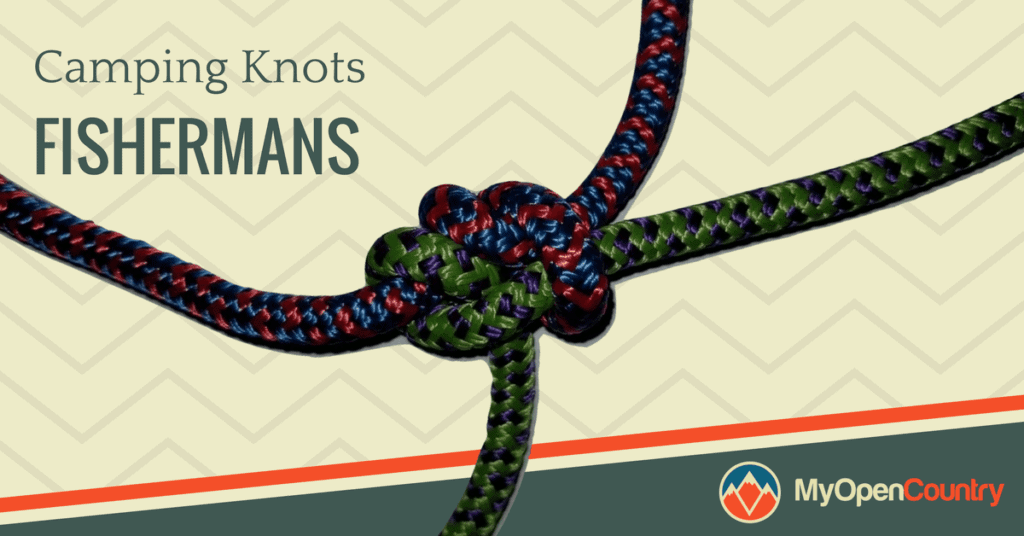I have a friend who has no patience with knots. Trying to teach him a few handy and versatile camping knots is a lost cause. He’s got the perspective “if you can’t tie a good knot, tie a lot”.
This approach had served him pretty well, until the time his Christmas tree went flying off the roof of his car. And that time his kayak drifted down the river without him. Or when the rainfly he set up over his tent took off and flew its way into stormy skies promising rain. Or… well, you get the point.
Knowing how to tie a handful of basic knots is a useful skill to add to your repertoire. They’re easy to learn and have multiple uses. In this guide, we’ll reveal how easy tying knots can be and what uses you can put them to by talking you through each type of knot.

Table of Contents
Basic Knot Terminology
Before looking at specific knots, we’ll take a gander at some basic terminology for describing knots:
- Working End: The part of the rope active in knot tying
- Standing End: The part of the rope not active in knot tying
- Turn: Rope that is “turned” around an object
- Jamming: Any knot that is very difficult to untie
- Eye: The correct term for what is often mislabeled as a loop
- Bight: A bight is a semicircle of rope bent into a U-shaped section
- Tail: The short end of a rope, the part that is being knotted

Different Types of Knots
I consider myself lucky because my day job is spent 100% outdoors. Working with my hands and planting trees in gardens and landscapes is pretty damn sweet. But before I can plant those trees, I need to safely transport them to their destination.
The knots for camping we’ll look at here, then, are something I’m painfully familiar with; I’ve got the rope burns on my palms to prove it. One of the first things I learned when cutting my teeth in the outdoors, however, is that not all “knots” are knots…
Here’s the big reveal:
The Knot
If we’re getting specific, a knot is supposed to be a “stopper” that prevents a rope from slipping through a bolt eye or similar structure. That’s some outdated nomenclature, though, so most people today call any knot, hitch, or bend a “knot”.
For our purposes, we’re addressing anything with the title “knot” as a knot, while any “hitch” is a hitch, and any “bend” is a bend.
Examples of Knots
Square, Bowline, Fisherman’s, Water, The Figure 8, Surgeon’s, Nail
The Hitch
Hitches are used to tie rope to another object, typically another piece or a cylindrical object such as a tree or stake. They’re useful for strapping down anything you’re transporting or want to keep under control.

When tying down a heavy load, I use a trucker’s hitch to add more tension before tying off the knot in the truck’s loading bed. When pitching my tent, I peg out guylines with a clove hitch because it’s easy to tie and adjust.
Examples of Hitch Knots
Half Hitch, Rolling Hitch, Taut Line Hitch, Clove Hitch, Round Tie and Two Half Hitches, Cat’s Paw, Barrel Hitch, Adjustable Grip Hitch
The Bend
Used to tie two different ropes together (like the hitch above). Bends are a very useful knot if you’ve got two different sizes of rope to tie together or are lengthening a cut piece. While preparing for heavy snowfall that could have toppled and split trees in our nursery, I used a sheet bend knot to join two pieces of rope instead of cutting a new length.
Examples of Bend Knots
Figure 8 Bend, Sheet Bend, Flat Overhand Bend, Hunter’s Bend, Beer Bend, Slim Beauty Bend
9 Essential Camping Knots (3 Bonus Knots to Follow!)

Half Hitch
This is a basic and easy camping knot used as the foundation for many others. It is not very secure on its own and needs to be doubled up to be effective. Nonetheless, it is an integral knot to understand for later learning more advance and trickier knots. To tie it you’ll need one rope and an object to tie it around.
How to Tie It
Run a loop around an object such as a pole or post. Pass the working end around the standing end and through the loop.
Suggested Uses
- Tying a rain fly quickly to a tree
- Anchoring your gear to an eye bolt on your vehicle

Overhand Knot
Another basic knot, the overhand is useful as an element of many other knots. By itself, it is useful as a stopper to prevent a loop from sliding beyond its intended placement. You probably already know how to tie this one even if you don’t know the name for it. You’ll need a single piece of rope for this camping knot.
How to Tie It
Make a loop and run the working end (the free end of the rope) through it. Tighten.
Suggested Uses
- Putting a stopper in the thread you’re using to patch a hole in your tent or pack

Sheet Bend
Also known as a Weaver’s Knot, the Sheet Bend is a simple knot and great for joining two pieces of rope together. I had two odd lengths of paracord while camping once and needed to string a tarp, for this situation the sheet bend was my camping knot of choice. You’ll use two lengths of rope for this one.
How to Tie It
Hold the two pieces of rope. In your left-hand hand, form a bight. Pass the second rope in your right hand through the bight and then behind the left-hand rope bight. Pull the working end through itself to complete.
Suggested Uses
- Combining two scrap pieces of rope to form a longer length
- Binding a rope around a bundle of firewood to keep it secure

Figure 8
With a bit of figuring the Figure 8 is easy to tie, but it might take some practice. This is a trustworthy camping knot used as a stopper and is easier to untie than an overhand knot. It also damages the rope less than a simple overhand knot.
How to Tie It
Form a loop and run the tail of the rope underneath the standing end. Pass the working end through the loop to create loops in a Figure 8.
Suggested Uses
- Use the Figure 8 as a stopper knot for any situation!
- Guy line lost its anchor point? Tie a Figure 8 to keep the rope from running through a grommet

Double Figure 8
This one will take some time and work to wrap your head around. The Double Figure 8 is an important knot used by climbers as it is an easily untied knot. Its structure allows for equal weight distribution between two points.
How to Tie It
Form a long bight in your rope. Create two double loops and make a Figure 8. Pull the end of the bight through the bottom of figure 8 and pull it into place. Run the original bight beneath, up, and then over the rest of the knot. Pull it tight to secure the two loops.
This video is an excellent instructional for a complicated knot to describe!
Suggested Uses
- Most often used during mountain climbing and caving expeditions
Helpful for holding the weight of different items when hanging a bear bag of your food out of the reach of a bear.

Square (or Reef) Knot
A knot most of us are familiar with, the square knot is simple and intended to tie two bunches of objects together securely. I’ve used it when bundling firewood and kindling together, or for packing up a tarp.
This is a very simple camping knot, especially when remembering the keywords “right over left, left over right”. You’ll need one piece of rope, and are tying one end to the other end.
How to Tie It
Meet the two ends of the rope together. Cross the right end over and around the left end, then cross the left end over and around the right end. Tighten. The key here is that you’re forming a knot that looks like a square.
Suggested Uses
- Limitless uses, but great for binding together bundles of firewood and stowing away bulky gear with a quick, simple knot

Taut Line Hitch
A nautical knot used by the Boy Scouts of America since 1910, the taut-line hitch is a revered movable knot that can be adjusted up or down a length of rope.
You can use this camping knot to attach the guy line of your tents to pegs, or for anchoring a boat to shore. This one takes a bit of practice to get right. You’ll need one length of rope, and a pole or similar object to tie around.
How to Tie It
Take your rope and do a single turn around the pole. Leave yourself a good bit of slack to finish this one. Run the tail end around the standing end twice. Continue for a third pass, but run the tail end between itself and over the standing end. Pull to tighten. The knot should be able to slide up and down freely.
Suggested Uses
- To hang a hammock (and easily adjust the tension – check out our hammock camping buyers guide)
- Tying your rainfly to stakes and trees alike with the Taut Line Hitch allows for on-the-fly adjustments
- Attaching to guy lines

Round Turn and Two Half Hitches
The Round Turn and Two Half Hitches is used to secure your rope to a pole, often as the basis for lashing objects together. It’s a knot that won’t easily jam even after it’s been beaten up, making it easy to untie. It’s a simple one to tie once you’ve mastered the half hitch.
How to Tie It
Do two complete turns around an object. Make one-half hitch and pull it tight, then make a second-half hitch in the same direction and pull it tight too. Most of the stress will be on the two complete turns, while the half hitches keep the rope secure.
Suggested Uses
- Perfect for guy lines because of its resistance to jamming
- Because of its resistance to fraying, perfect for tying to an abrasive item (like a metal ring or grommet)

Bowline Knot
Another popular camping knot, the bowline is a classic knot used to secure a load using a fixed loop. It doesn’t slip, but it also cannot be tied or untied when there’s weight on it. Some people will use two bowlines to join lengths of rope together. It seems tricky at first, but once you get the basics down it’s a cinch (pun intended). You’ll need one length of rope.
How to Tie It
Form a small loop with a good bit of slack at the end; the length of the slack determines the size of your loop.
Suggested Uses
- Almost limitless uses around the campsite, but ideal for lifting something above the ground (think of bear bags to stow your food)
- In an emergency, it could be used as a rescue knot to hoist a person from a precarious scenario
3 Bonus Knots

Clove Hitch
A simple one, the clove hitch is quick to learn but should never be used to securely hold something in place.
Use it as a temporary camping knot to hold something in place that won’t put much stress on the rope. I’ve used the clove hitch for tying back tree branches temporarily and when I’m in a rush. You’ll tie one length of rope to a post or pole.
How to Tie It
Run the working end over the pole for a complete turn, then cross over the standing end to form a second turn. Run the tail end under itself and tighten.
Suggested Uses
- Attaching your gear to a carabiner or other suspended object (hanging cooking pots and pans, a portable shower, etc)

Fisherman’s Knot
Especially useful for anglers, the Fisherman’s Knot is used to securely tie objects, such as a fishing hook, to the end of a rope. It can also be used to tie two lengths of rope together securely but becomes a difficult knot to untie the two ropes apart again.
How to Tie It
When tying an object to rope: Run the working end of your rope or line through the eye of the object. Wrap 4 – 5 loose turns over the standing line end. Bring the working end of your rope or line back through the eye of the object, passing it through each of the turns. Tighten and cinch the knot tight.
When tying two lengths of rope: Hold both ends of the rope together. Run the tail end of the right rope over and behind the left rope and tie an overhand knot. Repeat this process for the left rope. Tighten the knots, then pull the standing ends to pull the knots together.
Suggested Uses
- Ideally used for tying a hook to line! But can be used when you’re attaching anything with an eye hole to rope
- Perfect for securely binding two lengths of rope

Trucker’s Hitch
I use this more often than any other camping knot. It’s the most useful hitch you’ll find because it allows a length of rope to be pulled extremely tight.
The knot is very simple to learn; the only tricky part is learning the placement of where to position the Trucker’s Hitch, but that comes with a bit of practice. You’ll be tying this hitch into place on one length of rope.
How to Tie It
You’ll have one end of rope tied to an object like an eye bolt or car bumper.
Throw the rope over the load and determine the mid-way point of the rope. Here you’ll make a small loop in the rope. Feed the slack of your working end through the loop and tighten it. Run the tail end of your working end through an eye bolt or bumper, feed it into the loop and crank down to add tension to your line. Tie it off with a few half-hitches.
Suggested Uses
- Adding some serious oomph to the tension of your rope
- Perfect for stowing and packing up gear
- Securely bundling firewood
Tying it All Together
Basic knots for camping are well worth the practice it takes to learn them. The greatest benefit is knowing that the knot you tied is the right one, and there’s minimal possibility that your secured belongings are going to fall out of place.
Outside of backcountry camping trips, these knots are useful to use throughout daily life. Sometimes it’s as simple as securing a heavy load to your vehicle, and other times it could be using the right camping knot to bundle together a stack of newspapers for recycling.
A little bit of practice is always beneficial. Spend one night a week while watching TV or commuting practicing a few essential knots to keep your skills and memory sharp.
Did you find this guide on knot knowledge useful? If so, let us know in the comments box below. And please feel free to share it with your friends!

